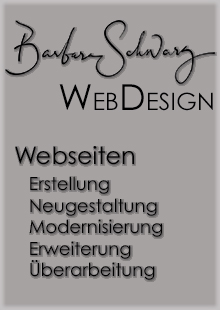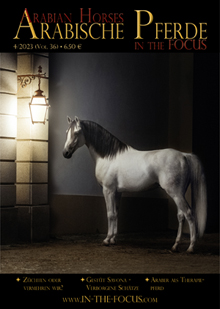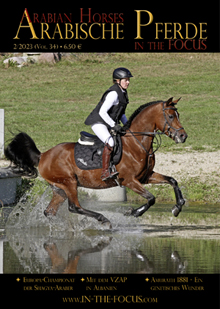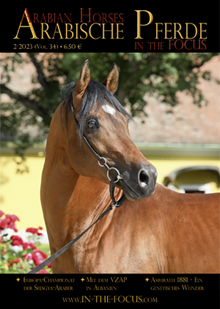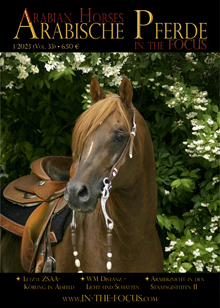Thanks to modern reproduction technology, we have today a wide range of possibilities of how to bring oocytes (eggcells) and sperms together. But is everything that is technically possible also sensible, desireable and ethically justifiable?

The fertility of his breeding stock is an important factor for any breeder not only with regards to breeding as such, but also as an economic aspect: The higher the fertility rate, the more profitable is breeding. If a mare has a foal only once every 2 or 3 years, the production costs of this foal are higher; if a lot of medical help is needed to get a mare pregnant, the same applies. But apart from the pure cost-benefit-aspects, there should be other points to be consider by breeders, too, for example should they think about the gene pool of the whole population, about the ethics of their doiong, especially with regards to the physical and mental welfare of their horses.
LIVE COVER
To demonstrate the changes that came along with modern reproduction methods, we should take the natural behaviour of our horses as a basis. This can be seen best in feral herds of horses (Mustangs in America, Brumbies in Australia, Carmargue horses in France). The typical family structure is that of a polygamous herd, i.e. one stallion lives with several mares in a herd. Often, such a harem consists of 1-5 mares, sometimes more. The stallion covers all mares of breeding age in his harem, all natural instincts involved in chosing a partner and covering a mare are allowed to take their own course. Covering as such is done as „natural service“, of course. The foaling rate depends a lot on the environment, in case of very adverse environmental factors, as it may happen in Australia during a drought, the rate may be as little as 20 % (i.e. 20 out of 100 coverings produce a living foal), while it may rise to 95 % in optimal conditions.
Today, our domestic horses are no longer living in herds, nevertheless, until the 1970ies the preferred method for covering a mare was „natural service“, even if the partner was chosen by us humans. But since then, a lot has happened:
Live cover – here we distinguish between „pasture breeding“, where stallion and mare mate free on the pasture without any help or interference by humans, and „hand breeding“, where the stallion is led to the mare, the mare often fixed to reduce injury. The pregnancy rate in pasture breeding is more than 90%, while in hand breeding it depends on the management and may be up to 85 %.
It is considered an advantage of pasture breeding that the mare will chose the time of covering which reduces the danger of injury; there will be repeated coverings and therefore high pregnancy rates.
The disadvantage of pasture breeding is given by a limited number of mares, that can be covered this way by one stallion; it is time consuming to include new members to an established herd.
The advantage of hand breeding is given in the fact that – if well planned and conducted (!) – part of the instincts are still active and can be lived. Further, a stallion can cover more mares, compared with pasture breeding, because the time consuming integration of a visiting mare into the herd (if possible at all) isn’t necessary.
It is regarded as disadvantageous, that the mare(usually) has to be transported to the stallion, which – especially with foal at foot – needs special effort and includeds a certain risk for injury. Transport and changing stables (stress) can reduce the mare’s readiness to breed. If the timing is not done carefully, the mating may become a „potential rape“, as the mare is usually fixed. Falls and injury due to defensive reactions are common. Insufficient preparation in both, pasture and hand breeding, may lead to infections of the sexual organs and transmission of infecteous diseases.
THE STANDARD IN HORSE BREEDING
Artificial insemination (AI) means the transfer of sperms with artificial (technical) methods or instruments into the sexual organs of a mare; this can be fresh semen, chilled semen or frozen semen. Fresh semen is commonly used if the mare shows an incompatibility with the extender. With chilled semen, the ejaculate is being examined, centrifuged, diluted, portioned and cooled. Semen prepared this way can be used up to 48 hourse after collection, depending on the stallion. With frozen semen, the ejaculate is being processed, frozen and stored in liquid nitrogene. This way, it can be stored over a long time and transported over a long distance. The first foal conceived from frozen semen was born 1957. In English Thoroughbred breeding, AI is not allowed.
The advantages of AI are to be seen in better hygiene, the possibility to inseminate several mares with one ejaculate, an acceptable pregnancy rate, a lower risk for horses and staff to get injured and less stress. Further, mares can be insaminated by AI independend of the place (chilled semen) or time (frozen semen). Also, the stallion can still be used for sport or show during the breeding season and frozen semen can even be used after the death of a stallion. AI is presently the standard in horse breeding. AI minimizes the risk for infections and achieves an acceptable fertility and foaling rate.
One of the disadvantages of AI is that not all stallions are equally suited for frozen semen. The quality of chilled semen can vary as well. Natural instincts will not be allowed or will be supressed, depending on management and procedures (especially on part of the mare).
INCREASING EXPENDITURE
With embryo transfer (ET), fertilization takes place in the donor mare. After 7-8 days, the embryo is flushed out of the donor mare and transferred to the recipient mare. The synchronisation of the oestrus cycles of donor and recipient mare is of great importance for the success rate. The embryo is retrieved by flushing out of the uterus. Tranfer is performed either invasive (not allowed in many countries for welfare reasons) or non-invasive through the cervix (neck of the uterus). Additionally, there is the option of deep-freezing the embryo, which allows its shipping and later use; however, the method is not yet fully developed.
The advantages of ET are that the donor mare can be used otherwise (sport, show); that a mare can be used for reproduction, even if her physical condition / health is not permitting to carry a foal; and that a genetically valuable mare can have more than one foal per year.
Under behavioural aspects it is of disadvantage that neither the donor mare nor recipient mare can live up to their appropriate sexual behaviour. The foal does not grow up with its biological mother, and will be imprinted by another mare with regards to certain behavioural patterns (dominance, „determination to win“, self-confidence, etc). The removal of ovaries (ovariectomy) in the recipient mare must be refused on ethical grounds. Where ET is used to have foals from infertile mares, there is the risk that the offspring will carry the same genetic disposition for the underlying health problem. Any „superovulation“ with up to 35 embryos as is known from cattle, is not (yet) possible in horses, where only around 2-5 embryos per year can be achieved.
BREEDING WITH INFERTILE PARENTS
In-vitro-fertilization (IVF) is basically a special case of embryo transfer. In this case, fertilization does not take place within the body of the mare, but an oocyte has been extracted from the donor mare. There are two methods of extraction, firstly the extraction of oocytes which matured „in vivo“ (in the body of the mare) during oestrus (during season), and secondly the extraction of „immature“ oocytes independent of the oestrus. The latter technique allows to increase the number of oocytes, but these immature cells have to mature „in vitro“. Then the mature oocyte is incubated with sperms in a „test tube“, followed by fertilization (i.e. penetration of a sperm into the oocyte), all taking place outside the womb of a mare, hence the name „in vitro“ (in a glass). The fertilized oocyte will then be cultivated in an incubator and checked for quality. The resulting embryo will be implanted into a recipient mare. The first foal born from such in vitro fertilization was born in 1990.
The advantage of IVF are similar to ET, natural selection of the sperms with sufficient mobility is being maintained to a certain degree.
The disadvantages are also similar to ET, but the costs are higher. Especially the extraction of immature oocytes is questionable under animal welfare aspects, as aspiration or even an operation is necessary to get them.
Intracytoplasctic Sperm Injection (ICSI) is again a special case of IVF, where scientists went one step further. For ICSI, one single sperm is sufficient, which will be implanted with a needle into the oocyte. This way, the acrosome reaction is skipped, which in natural fertilization enables the sperm to penetrate the oocyte membranes by distribution of enzymes.
The advantage of ICSI is seen in the fact, that even infertile stallions, as long as they are still able to produce viable sperms, can be used for breeding. Another field would be, if, for example, there is only a limited number of sperms available of a deceased stallion, which need to be used to their optimum.
It is considered a disadvantage that, due to the missing acrosome reaction, the selection of most mobile and fast sperms is being eliminated and with it another part of natural selection disabled. Actually, it is possible with ICSI, to produce a foal from an infertile mare and an infertile stallion; however the foal may carry the genetic disposition for whatever caused the infertility of its parents.
Yet another special case that can be used on top of any of the artificial insemination methods, is the use of „sexed semen“. This means, the sperms are seperated before use into „male“ and „female“ sperms by flow cytometry; this way a foal of the preferred sex can be produced. The first foal produced this way was bron in 2004.
Advantage – you can decide on the sex of the foal in advance.
Disadvantage – with this technique, the total number of sperms is significantly reduced, it is only possible with very good sperm quality.
CLONING – NO SCIENCE FICTION ANYMORE
The most extreme method of reproduction is the production of embryos by somatic cloning. Here, the nucleus of an oocyte is being removed and replaced by the nucleus (including the DNA) of a body cell of a mature horse (donor). The resulting embryo is then tranferred into the utrerus of a recipient mare. The foal has then more or less the same genetic outfit as the horse of the donor cell. The first cloned foal was born in 2003.
Advantage – with cloning, even a (successful sports) gelding can have offspring, whose genetic potential would otherwise be lost for the breed.
Disadvantage – high costs of 150.000 to 250.000 €, without the guarantee that the foal has the same characterstics as the genetic parent. Apart from that, a high number of embryos need to be produced to finally have one living clone. A high percentage of clones has limited health. Of the healthy foals, it is not yet sure, if they have less life expectancy or if they will develop more diseases with aging than their peers with two parents.
AND THE MORAL OF THE STORY IS…?
As is often the case in animal „production“, there are controversial opinions also in horse breeding, especially when it comes to the very technically advanced reproduction methods such as ET, IVF, ICSI or cloning. On the one side there are the moral values, such as dignity of a living being, no instrumentalisation of animals, freedom from bodily harm, avoidance of pain and stress, and on the other side economical interests. If we accept artificial insemination as ethically justifiable, because in this case the advantages outweigh the disadvantages, and because it is possible with some effort to give the horses some sexual stimulation during the process, any further reproduction methods are seen quite critically by many people.
These methods are usually only justified by economic aspects – and even reasons such as „valuable genetic material“, or „infertile stallion or mare would be lost for the breed“ are actaully only economical reasons. These are not only in the interest of certain breeders, but also in the interest of reproduction centers, which are offering these options and advertise them accordingly. And so you can find advertising slogans, in which they tell us that you can have a foal with a biological dam that is infertile and sired by an infertile stallion. But is this sensible? Do we wish to breed future infertile horses – which then will flush more money into the pockets of the reproduction centers, which are needed to breed on with these infertile horses? And what is actually the „economic value“ of a horse? Usually the price somebody is prepared to pay. This price will become higher, the higher the chances to gain fame, glory and money. Prizemoney in the millions, as they are given in the Middle East, push the sale prizes up and increas the „value“ of certain bloodlines and certain individuals, which then have to be exploited „at any cost“ – even with three and more foals per year per mare. The embryos are then sold through embryo auctions, even before the foal is born. All this is not a vision for the future, but already reality in Arabian horse breeding.
Each breeder should ask himself the question, if we should allow this development in Arabian horse breeding unrestrained. It is the duty of each National Breed Association, to determine the maximum number of foals per year per mare produced by embryo transfer. Each member can – with a respective motion and his vote –set the course. WAHO, the World Arabian Horse Organisation who is responsible for the studbooks of purebred Arabians, has discussed the problems at their last General Meeting in November 2011 in Qatar, and has left the decision to the National Arab Breed Associations to find an appropriate limitation for embryo transfers (see rule 18). However, according to WAHO Rules no foal produced by IVF, shall be registered in any studbook, the same applies to clones and their offspring.
In English Thoroughbred breeding a clear decision was made many years ago, i.e. artificial insemination (and all other artificial reproduction methods) are not allowed. The Thoroughbred Associations of about 70 countries have signed an agreement, that horses, which are not produced and born by natural ways, are not allowed to race – and the English Thoroughbred has not become extinct yet, neither has there been a step backwards in breeding, while all these methods could not be used. And all this dispite the fact that there is a lot of money invovled in racing, too!
Gudrun Waiditschka
WAHO Rules concerning the subject
RULE 18: EMBRYO TRANSFER AND OVUM TRANSFER
Each Registering Authority Member has the authority to allow or not allow the use of Embryo Transfer or Ovum Transfer within their area.
The following registration rules have been designed to allow the Registering Authority to monitor this process effectively from the initial request of the Embryo or Ovum Transfer Permit to the registration of the resultant foal. They are the minimum rules required. The amount of fees or any additional requirements are at the discretion of WAHO Registering Authority Members.
1. IMPORTED HORSES PRODUCED BY EMBRYO TRANSFER OR OVUM TRANSFER
It is a mandatory rule that all WAHO Registering Authority Members must register imported horses produced by this method.
2. NUMBER OF FOALS PER YEAR PER DONOR MARE
Registration Authorities may, at their discretion or following legal advice, choose to place a specified limit on the number of foals they will register per donor mare per year according to the laws and culture of that country. They may also, at their discretion, allow multiple foals per donor mare. Whichever they choose, every Registering Authority Member must furnish WAHO with a copy of their Embryo Transfer or Ovum Transfer rules.
RULE 19: CLONING
1. It is a mandatory WAHO rule that any Arabian of any age produced by cloning must not be registered under any circumstances.
2. It is a mandatory WAHO rule that the foals of any Arabian which was produced by cloning cannot be registered.
RULE 20: EXTERNAL FERTILISATION OF OOCYTES FOR EMBRYO TRANSFER
1. It is a mandatory WAHO rule that any Arabian of any age produced by the post-mortem collection of oocytes must not be registered under any circumstances.
2. It is a mandatory WAHO rule that any Arabian of any age produced by any method of In Vitro Fertilisation (IVF) must not be registered under any circumstances. Effective from 1st January 2013.








